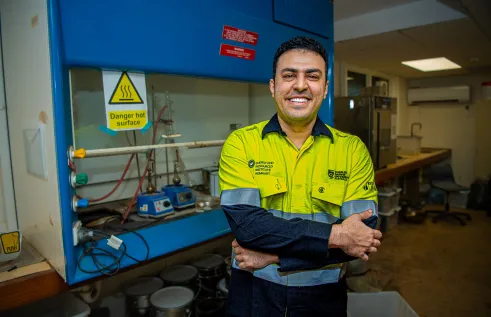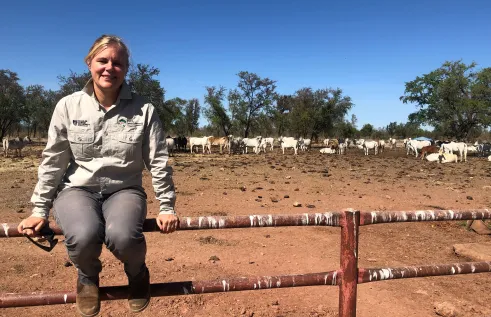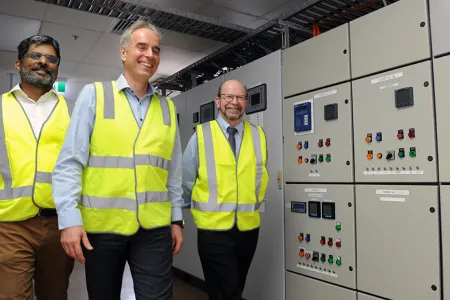News Article
Renewable energy focus builds at CDU
Charles Darwin University has taken carriage of a facility that will enable industry and government to continue to ensure the reliable flow of energy throughout the vast expanse of the Northern Territory and further integrate renewable and conventional energy.
The hand-over of the Microgrid Control Systems Testing Facility from Hitachi ABB Power Grids comes as CDU launches its Energy and Resources Institute (ERI) to develop world-class expertise in the energy and mining sectors.
CDU Vice-Chancellor Professor Simon Maddocks said the institute was formed through a merger of the North Australian Centre for Oil and Gas (NACOG) and the Centre of Renewable Energy (CRE), and the microgrid facility would provide the critical infrastructure to support research and training into the future.
“The research at the ERI using the facility will be highly relevant not only to the NT, particularly remote areas where there are multiple energy inputs, but also for other parts of Australia and the world,” Professor Maddocks said.
Professor Maddocks said that Hitachi ABB Power Grids had generously donated the facility located at the Smart Energy Hub, in the East Arm industrial precinct.
“The capabilities of this testing facility are unique and will assist CDU to address the challenges that come with incorporating multiple forms of renewable generation needed to support a carbon neutral energy future. Grids that are flexible, stronger, smarter and greener will create social, environmental and economic value for future generations,” said Bernard Norton, Managing Director – Australia, Hitachi ABB Power Grids.
The facility was purpose built by Hitachi ABB Power Grids as a power station simulator to enable scenario testing to help solve some of the NT’s power issues, such as integration of high amounts of solar energy as well as providing seamless transition to local supply when the power systems were either overloaded or sections disconnected after natural hazards such as lightning strike.
ERI Director Professor Suresh Thennadil said there were various configurations of renewable and conventional energy that had to be achieved to maintain reliable energy flow.
“The major challenge in achieving a high proportion of renewable energy (especially solar PV) in power grids is the instability and unreliability of the grid due to the intermittent and hard-to-predict nature of the renewable sources,” Professor Thennadil said.
“In order to achieve the 50% NT Government target and further to net zero emissions, it is essential to develop innovative methods that can deliver safe and stable operation of high-penetration renewable energy grids. Using this facility, we can conduct scenario testing of an energy system from anywhere in the world.”
He said that the ERI would foster collaborations with industry and government to help overcome the technological barriers to achieving 50% or more renewable energy in grids.
“In addition to our continuing collaborations with Hitachi-ABB, two projects are expected to start with the Northern Territory Government Office of Sustainable Energy and Power and Water, to study the Darwin-Katherine System (DKS),” he said.
CDU is also exploring opportunities to use the testing facility as a training tool for engineers and operators of Remote Area Power Systems.
Related Articles

Where rubber meets the road: Old tyres are key to building tougher roads
Almost half of the Northern Territory’s worn-out tyres end up in landfills – with the rest exported interstate for recycling – but a study led by Charles Darwin University (CDU) is repurposing the discarded rubber to build stronger, sustainable roads that meet the NT’s unique needs.
Read more about Where rubber meets the road: Old tyres are key to building tougher roads
Moo-ving the boundaries: New research evaluates virtual fences for use on NT cattle stations
Cattle producers in Northern Australia face unique challenges when adapting tools like virtual fences on their properties, but new research from Charles Darwin University (CDU) is set to break down the barriers to this technology.
Read more about Moo-ving the boundaries: New research evaluates virtual fences for use on NT cattle stations
Cotton trash to treasure: Project using waste to grow new mushroom industry
Supermarket shelves could be stocked with mushrooms grown from the Northern Territory’s cotton waste, with a Charles Darwin University research project exploring the possibility of broadening the region’s agricultural industry.
Read more about Cotton trash to treasure: Project using waste to grow new mushroom industry
